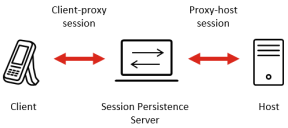Introduction
Session Persistence Server (known in earlier versions as TermProxy and ConnectPro) is designed to extend the life of sessions between clients (such as Velocity Clients or Terminal Emulation Clients) and hosts. Under normal operating circumstances, a device might go idle, enter power-saving mode, or move out of Wi-Fi range and prematurely terminate the session between the client and the host. Session Persistence Server software maintains the session with the host, even if the device goes to sleep or the connection is momentarily lost. This enables the Client to seamlessly resume the session without loss of productivity.
Functional Overview of Session Persistence Server
Session Persistence Server acts as an intermediary or proxy server between a client and a host, maintaining an established session with the host even though the client might go idle or otherwise terminate the session. The process occurs in the following manner:
1.The client establishes a session with the proxy server. This is called the client-proxy connection.
2.The proxy server establishes a session with the host on behalf of the client and keeps track of the session information. This is called the proxy-host connection.
3.The proxy server maintains the proxy-host connection, even if the client‑proxy connection goes idle or dead. (You can configure the length of time that the proxy server maintains the proxy-host connection after the client-proxy connection has been terminated.)
4.When a client re-connects after having been idle or having otherwise terminated the session, the proxy server sends the client the session information and the client continues the session. Block-mode emulations, such as 5250 and 3270, should use a reconnect string. Character-mode emulations, such as VT100 and VT220, do not require a reconnect string.
The following figure provides a conceptual overview of this process.
Session Persistence Server Features
The following list describes additional features that Session Persistence Server offers:
•Web Interface. Session Persistence Server offers a web interface that allows you to configure Session Persistence Server, view log files, view data captures, delete Client-proxy or proxy-host sessions, and review the status of proxy services. Sessions with the Session Persistence Server web interface can be encrypted using SSL, TLS, or SSH.
•Thousands of Concurrent Sessions. Session Persistence Server can support a maximum of 5000 concurrent Client sessions. If you plan on supporting a large number of Clients (up to 5000), ensure that the host system meets the proper Session Persistence Server specifications. (For information on host system requirements, see Installing Session Persistence Server .) Session Persistence Server and the Client can be configuring with timeout or terminate-on-exit options that may help free up unused or idle connections.
•Suspend/Resume Host Services. Session Persistence Server allows you to suspend additional connections to the proxy service. All current connections remain functional, but new connections are denied until you resume the service.
•Multiple Proxy Sessions per Client. Session Persistence Server supports multiple proxy sessions for each device.
•SSL, TLS, or SSH Support. Session Persistence Server supports SSL/TLS or SSH for encryption and verification when connecting to the web interface or for Client-proxy connections.
•Data Capture Filter. Session Persistence Server can capture data from a single Client, from multiple Clients, or from all Clients. Captured data is stored in a text file on the proxy host system. View the text file either manually or through the Session Persistence Server web interface.
